Snow Joe 24V-X2-20SB Handleiding
Snow Joe
Sneeuwblazer
24V-X2-20SB
Bekijk gratis de handleiding van Snow Joe 24V-X2-20SB (68 pagina’s), behorend tot de categorie Sneeuwblazer. Deze gids werd als nuttig beoordeeld door 73 mensen en kreeg gemiddeld 4.7 sterren uit 37 reviews. Heb je een vraag over Snow Joe 24V-X2-20SB of wil je andere gebruikers van dit product iets vragen? Stel een vraag
Pagina 1/68

1
Model 24V-X2-20SB Form No. SJ-24V-X2-20SB-880E-MR3
CORDLESS SNOW BLOWER
48V MAX* | 4.0 Ah | 20-INCH | LED LIGHTS
© 2021 by Snow Joe
®, LLC
All rights reserved. Original instructions. SAVE THESE INSTRUCTIONS
A Division of Snow Joe
®, LLC
OPERATOR’S MANUAL
EN
R
IMPORTANT!
Safety Instructions
All Operators Must Read These
Instructions Before Use
Read all instructions when using cordless snow blowers. Basic
safety precautions should always be followed to reduce the
risk of re, electric shock, and personal injury.
General Safety Rules
Notice the personal safety alert symbol used in this m
manual to draw your attention to a WARNING given along
with the particular operating instruction. This means that
the operation requires special ATTENTION, CAUTION, and
AWARENESS.
• Keep work area clean and well lit – Cluttered, dark areas
invite accidents.
• Keep bystanders away – All bystanders and pets should
be kept a safe distance away from the work area.
• Dress properly – lry. Do not wear loose clothing or jewe
They can get caught in moving parts. Protective rubber
gloves and non-slip footwear are recommended when
working outdoors.
• Use the right product – Do not use this machine for any
job except that for which it is intended.
• mCAUTION! – Exercise caution to avoid slipping or falling.
Wear protective footwear that will protect your feet and
improve your footing on slippery surfaces.
• Also use safety footwear, snug-tting Use safety glasses –
clothing, protective gloves, hearing and head protection.
• Do not force the snow blower – Use the snow blower
at the rate for which it was designed to ensure optimal
performance and safe operation.
• Stay alert – Watch what you are doing. Use common
sense. Do not operate the snow blower when you are tired
or under the inuence of alcohol or drugs.
• Do not overreach – Keep proper footing and balance at
all times.
• Store indoors – When not in use, the snow blower should
be kept dry and stored out of the reach of children in a high
or locked place.
• Maintain snow blower with care – Follow instructions for
lubricating and changing accessories.
mWARNING! Always disengage the switch lever and
remove the battery packs before making any adjustments,
inspecting, servicing, changing accessories, cleaning the snow
blower, or when any other dangerous conditions are present.
Any such operation should be performed after revolving parts
inside the snow blower stop completely. Such preventive
safety measures reduce the risk of starting the power tool
accidentally.
mWARNING! When replacing any parts, you must strictly
observe the instructions and procedures described in this user
manual. Special care should be paid to any rubber parts,
since these parts may increase the motor load and decrease
its mechanical power if damaged.
mWARNING! If you notice that the snow blower is not
running properly or hear abnormal sounds from the motor
when it is in use, immediately stop the machine, remove the
batteries, and contact your service center.
• Surfaces – This snow blower is intended for use on
paved surfaces. Do not use on gravel, stone or other
unpaved surfaces unless the snow blower is adjusted for
such surfaces according to the instructions given in the
operator’s manual.
• Moving parts present risks – Keep your face, hair,
clothing, hands, and feet away from moving parts.
All guards and safety attachments must be installed
properly before using the unit. Shut o and disconnect the
battery before touching any parts other than the handles
and switch.
• Avoid unintentional starting – Make sure the safety switch
and the switch lever are in the o position before inserting
the batteries in the unit. Do not carry the snow blower with
the safety switch and the switch lever engaged.
• Do not overreach – Maintain proper footing and balance
at all times. Place heels rmly on the ground and tightly
grasp the handle bar. Watch for uneven surfaces and do not
overreach. In case you fall or collide with the snow blower,
inspect the unit for any damages or cracks. When stepping
backwards, be careful to avoid obstacles beneath your feet
or behind you to avoid falling.
• Wear rubber boots when operating the snow blower.
• Operation of the snow blower in the hand-held position is
unsafe, except in accordance with the special instructions
for such use provided in the operator's manual.
• Keep guards in place and in working order.

2
mWARNING! If the snow blower strikes any object,
follow these steps:
i) Stop the snow blower. Remove the batteries.
ii) Inspect for damage.
iii) Repair any damage before restarting and operating
the snow blower.
Electric Safety
mWARNING! Read all safety warnings and instructions.
Failure to follow the warnings and instructions may result in
electric shock, re and/or serious injury.
1. Prevent unintentional starting. Ensure the switch is in the
o-position before connecting with battery packs, picking
up or carrying the appliance. Carrying the appliance with
your nger on the switch or energizing appliance that have
the switch on invites accidents.
2. Remove the battery packs from the appliance before
making any adjustments, changing accessories, or storing
appliance. Such preventive safety measures reduce the
risk of starting the appliance accidentally.
3. Recharge only with the charger specied by the
manufacturer. A charger that is suitable for one type of
battery pack may create a risk of re when used with
another battery pack.
4. Use appliances only with specically designated battery
packs. Use of any other battery packs may create a risk of
injury and re.
5. When battery packs are not in use, keep them away from
other metal objects, like paper clips, coins, keys, nails,
screws or other small metal objects, that can make a
connection from one terminal to another. Shorting the
battery terminals together may cause burns or a re.
7. Under abusive conditions, liquid may be ejected from
the battery; avoid contact. If contact accidentally occurs,
ush with water. If liquid contacts eyes, additionally seek
medical help. Liquid ejected from the battery may cause
irritation or burns.
8. Do not use a battery pack or appliance that is damaged
or modied. Damaged or modied batteries may exhibit
unpredictable behavior resulting in re, explosion or risk of
injury.
9. Do not expose a battery pack or appliance to re or
excessive temperature. Exposure to re or temperature
above 265°F (130°C) may cause explosion.
10. Follow all charging instructions and do not charge the
battery packs or appliance outside of the temperature
range specied in the instructions. Charging improperly
or at temperatures outside of the specied range may
damage the batteries and increase the risk of re.
11. Have servicing performed by a qualied repair person
using only identical replacement parts. This will ensure
that the safety of the product is maintained.
12. Do not modify or attempt to repair the appliance or the
battery packs (as applicable) except as indicated in the
instructions for use and care.
Battery & Charger
Safety Instructions
We pay a great deal of attention to the design of every battery
pack to ensure that we supply you with batteries that are safe,
durable and have a high energy density. The battery cells have
a wide range of safety devices. Each individual cell is initially
formatted and its electrical characteristic curves are recorded.
This data is then used exclusively to be able to assemble the
best possible battery packs.
Despite all the safety precautions, caution must always be
exercised when handling batteries. The following points must
be obeyed at all times to ensure safe use. Safe use can only
be guaranteed if undamaged cells are used. Incorrect handling
of the battery pack can cause cell damage.
IMPORTANT! Analyses conrm that incorrect use and poor
care of high-performance batteries are the main factors
responsible for personal and/or product damage.
mWARNING! Read all safety warnings and instructions.
Failure to follow the warnings and instructions may result in
electric shock, re and/or serious injury.
mWARNING! Use appliances only with specically
designated battery packs (see page 18 for all specically
designated battery packs). Unauthorized battery packs may
create a risk of injury and re.
mCAUTION! To reduce the risk of injury, charge the
24V iON+ lithium-ion battery packs only in the designated
24V iON+ lithium-ion charger. Other types of chargers present
risk of re, personal injury and damage. Do not wire a battery
pack to a power supply plug or car cigarette lighter. Such
misuse will permanently disable or damage the battery pack.
• Avoid dangerous environments – Do not charge the
battery packs in rain, snow or in damp or wet locations.
Do not use the battery packs or charger in the presence of
explosive atmospheres (gaseous fumes, dust or ammable
materials) because sparks may be generated when inserting
or removing the battery packs, which could lead to a re.
• Charge in a well-ventilated area – Do not block the
charger vents. Keep them clear to allow for proper
ventilation. Do not allow smoking or open ames near a
charging battery pack. Vented gases may explode.
The safe temperature range for the battery is NOTE:
41°F – 105ºF (5°C – 40.5°C). Do not charge the battery
outside in freezing weather; charge it at room temperature.
• Maintain charger cord – When unplugging the charger,
pull the plug, not the cord, from the receptacle to reduce
the risk of damage to the electrical plug and cord. Never
carry the charger by its cord or yank it by the cord to
disconnect it from the receptacle. Keep the cord away

3
from heat, oil and sharp edges. Make sure the cord will not
be stepped on, tripped over or subjected to damage or
stress when the charger is in use. Do not use the charger
with a damaged cord or plug. Replace a damaged charger
immediately.
• Do not use an extension cord unless it is absolutely
necessary – Using the wrong, damaged or improperly
wired extension cord poses a risk of re and electric shock.
If an extension cord must be used, plug the charger into a
properly wired 16 gauge or larger extension cord with the
female plug matching the male plug on the charger. Make
sure that the extension cord is in good electrical condition.
• Charger 24VCHRG-DPC is rated for 120 volt AC
only – The charger must be plugged into an appropriate
receptacle.
• Use only recommended attachments – Use of an
attachment not recommended or sold by the battery
charger or battery pack manufacturer may result in risk of
re, electric shock or personal injury.
• Unplug charger when not in use – Make sure to remove
battery packs from unplugged charger.
mWARNING! To reduce the risk of electric shock,
always unplug the charger before performing any cleaning
or maintenance. Do not allow water to ow into the charger.
Use a Ground Fault Circuit Interrupter (GFCI) to reduce shock
hazards.
• Do not burn or incinerate battery packs – Battery
packs may explode, causing personal injury or damage.
Toxic fumes and materials are created when battery packs
are burned.
• Do not crush, drop or damage battery packs – Do not
use the battery packs or charger if they have sustained a
sharp blow, been dropped, run over or have been damaged
in any way (i.e. pierced with a nail, hit with a hammer,
stepped on, etc.).
• Do not disassemble – Incorrect reassembly may pose
a serious risk of electric shock, re or exposure to toxic
battery chemicals. If the batteries or charger are damaged,
contact an authorized Snow Joe® + Sun Joe® dealer or
call the Snow Joe® + Sun Joe® customer service center at
1-866-SNOWJOE (1-866-766-9563) for assistance.
• Battery chemicals cause serious burns – Never let a
damaged battery pack contact the skin, eyes or mouth. If a
damaged battery pack leaks battery chemicals, use rubber
or neoprene gloves to safely dispose of it. If skin is exposed
to battery uids, wash the aected area with soap and
water and rinse with vinegar. If eyes are exposed to battery
chemicals, immediately ush with water for
20 minutes and seek medical attention. Remove and
dispose of contaminated clothing.
• Do not short circuit – A battery pack will short circuit if
a metal object makes a connection between the positive
and negative contacts on the battery pack. Do not place a
battery pack near anything that may cause a short circuit,
such as paper clips, coins, keys, screws, nails and other
metallic objects. A short-circuited battery pack poses a risk
of re and severe personal injury.
• Store your battery packs and charger in a cool,
dry place – Do not store the battery packs or charger where
temperatures may exceed 105ºF (40.5ºC), such as in direct
sunlight or inside a vehicle or metal building during the
summer.
Information about the batteries
1. The battery packs supplied with your cordless snow
blower are only partially charged. The battery packs have
to be charged completely before you use the tool for the
rst time.
2. For optimum battery performance, avoid low discharge
cycles by charging the battery packs frequently.
3. Store the battery packs in a cool place, ideally at 59°F
(15°C) and charged fully.
4. Lithium-ion batteries are subject to a natural aging
process. The battery packs must be replaced at the latest
when the capacity falls to just 80% of the capacity when
new. Weakened cells in an aged battery pack are no
longer capable of meeting the high power requirements
needed for the proper operation of your snow blower,
and therefore pose a safety risk.
5. Do not throw battery packs into an open re as this poses
a risk of explosion.
6. Do not ignite the battery packs or expose them to re.
7. Do not exhaustively discharge batteries. Exhaustive
discharge will damage the battery cells. The most
common cause of exhaustive discharge is lengthy storage
or non-use of partially discharged batteries. Stop working
as soon as the performance of the battery falls noticeably
or the electronic protection system triggers. Place the
battery packs in storage only after it has been fully
charged.
8. Protect the batteries and the tool from overloads.
Overloads will quickly result in overheating and cell
damage inside the battery housing even if this overheating
is not apparent externally.
9. Avoid damage and shocks. Immediately replace batteries
that have been dropped from a height of more than one
meter or those that have been exposed to violent shocks,
even if the housing of the battery pack appears to be
undamaged. The battery cells inside the battery may have
suered serious damage. In such instances, please read
the waste disposal information for proper battery disposal.
10. If the battery packs suer overloading and overheating,
the integrated protective cuto will switch o the
equipment for safety reasons. If this situation happens,
stop the tool and let the batteries cool down for a few
minutes before restarting.
IMPORTANT! Do not press the ON/OFF trigger any more
if the protective cut-o has been activated. This may
damage the battery packs.
11. Use only original battery packs. The use of other batteries
poses a re risk and may result in injuries or an explosion.
Product specificaties
| Merk: | Snow Joe |
| Categorie: | Sneeuwblazer |
| Model: | 24V-X2-20SB |
Heb je hulp nodig?
Als je hulp nodig hebt met Snow Joe 24V-X2-20SB stel dan hieronder een vraag en andere gebruikers zullen je antwoorden
Handleiding Sneeuwblazer Snow Joe

27 Februari 2024

3 Augustus 2023

16 Juni 2023

16 Juni 2023

12 Juni 2023

29 Mei 2023

26 Mei 2023

25 Mei 2023

21 Mei 2023

14 Mei 2023
Handleiding Sneeuwblazer
- Yato
- Antari
- Yard Force
- Meec Tools
- Toro
- Karcher
- Einhell
- DJPower
- Alpina
- Biltema
- Craftsman
- Power Craft
- Cotech
- American DJ
- Hurricane
Nieuwste handleidingen voor Sneeuwblazer
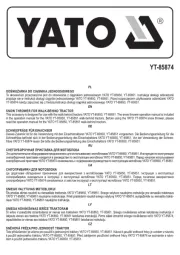
15 Juli 2025
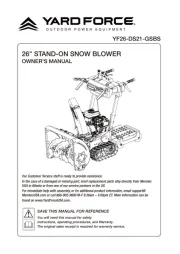
20 Mei 2025
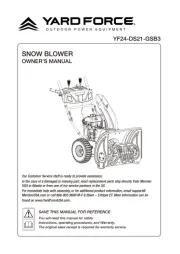
20 Mei 2025
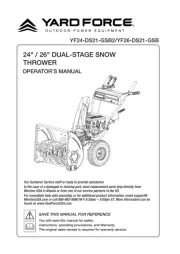
15 Mei 2025
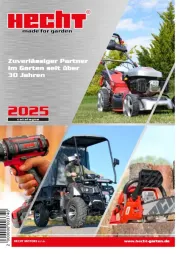
27 Januari 2025
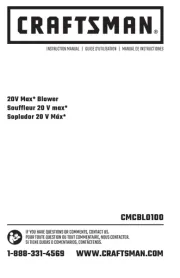
27 Januari 2025

9 December 2024

4 December 2024

4 December 2024
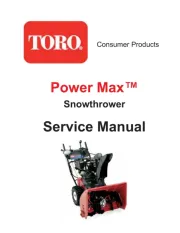
19 November 2024